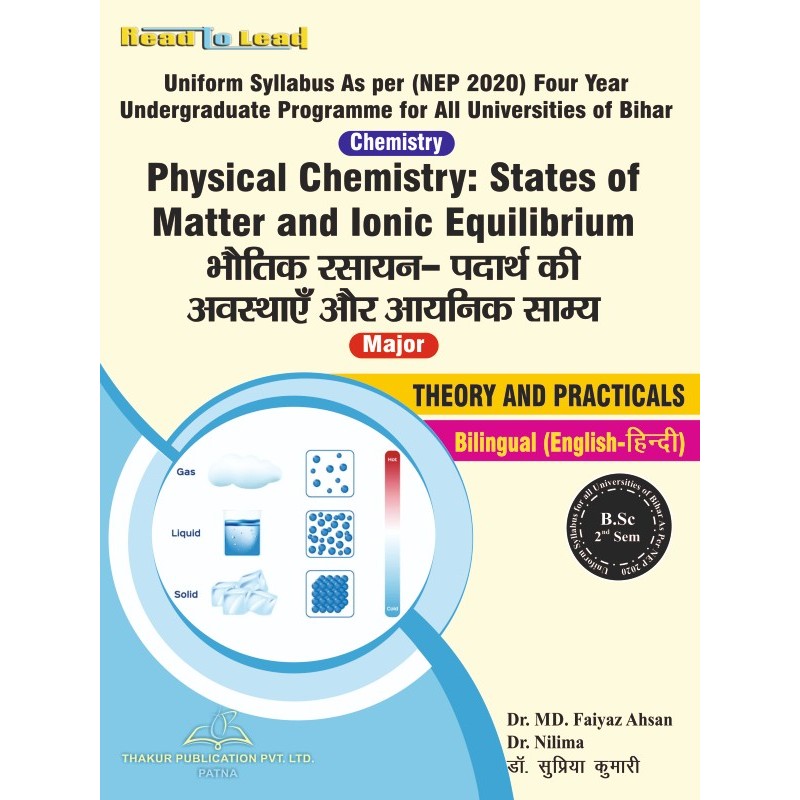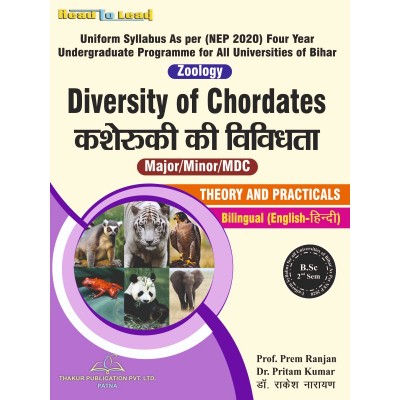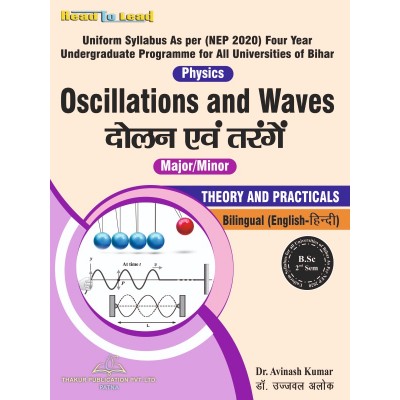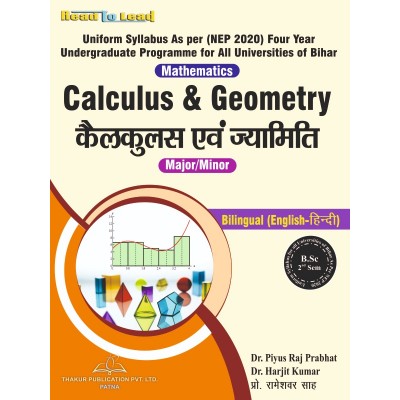Physical Chemistry : States of Matter and Lonic Equilibrium ( भौतिक रसायन पदार्थ की अवस्थाएँ और आयनिक साम्य ) B.Sc 2nd
Tax excluded
Click below to Buy E-Book Edition:
Buy Latest Chemistry ( Physical Chemistry : States of Matter and Lonic Equilibrium) (Major) ( भौतिक रसायन पदार्थ की अवस्थाएँ और आयनिक साम्य ) Book in Bilingual Edition ( Both English and Hindi ) for B.Sc 2nd Semester Uniform Syllabus for all Universities of Bihar AS Per NEP 2020. Published By Thakur Publication. Written by Experienced Authors | Fast & All India Delivery |
Authors : Dr. MD. Faiyaz Ahsan , Dr. Nilima ,Dr. Supriya Kumari
ISBN : 9789357555654
Syllabus
Physical Chemistry: States of Matter and Ionic Equilibrium
|
Unit |
Topics |
No. of Lectures |
|
1 |
Gaseous State: Kinetic molecular model of a gas postulates and concept of an Ideal gas, Derivation of the kinetic gas equation and various gas laws; Maxwell's Distribution of Molecular velocities and its use in evaluating different types of molecular velocities – Most Probable Velocity, Average (Mean) Velocity, Root Mean Square (RMS) Velocity, and Average kinetic energy; Relationship between various molecular velocities; Law of equipartition of energy, degrees of freedom and molecular basis of heat capacities.
Viscosity of gases, co-efficient of viscosity and its dependence on temperature and pressure; Collision frequency, Collision diameter and Mean free path; Relationship between mean free path (l) and co-efficient of viscosity (h), Calculation of collision diameter (s) from co-efficient of viscosity (h).
Behaviour of Real Gases: Deviations form ideal gas behavior, compressibility factor Z, and its variation with pressure for different gases; Causes of deviation from ideal behaviour. Equation of states for real gases; Van der Waals equation of state, its derivation and application in explaining real gas behaviour, Virial coefficients, calculation of Boyle temperature; Isotherms of real gases and their comparison with van der Waals isotherms, continuity of states, critical state & critical constants, relation between critical constants and van der Waals constants, law of corresponding states. |
12 |
|
2 |
Liquid State: Qualitative treatment of the structure of the liquid state; physical properties of liquids; vapour pressure, surface tension and coefficient of viscosity, and their determination. Effect of addition of various solutes on surface tension and viscosity. Explanation of cleansing action of detergents. Temperature variation of viscosity of liquids and comparison with that of gases. |
08 |
|
3 |
Solid State: Nature of the solid state, law of constancy of interfacial angles, law of rational indices, miller indices, elementary ideas of symmetry, symmetry elements and symmetry operations, qualitative idea of point and space groups, seven crystal systems and fourteen Bravais lattices;x-ray diffraction, Bragg'slaw, a simple account of rotating crystal method and powder pattern method; Analysis of powder diffraction patterns of NaC1, CsCl and KCl. |
08 |
|
4 |
Ionic Equilibria: Strong, moderate and weak electrolytes, degree of ionization, factors affecting degree of ionization, ionization constant and ionic product of water. Ionization of weak acids and bases,dissociation constants of mono and diprotic acids; pH and pOH, pH scale; common ion effect; Salt hydrolysis, calculation of hydrolysis constant, degree of hydrolysis and pH for different salts. Bufffer solutions; derivation of Henderson equation and its applications: Solubility product of sparingly soluble salts, applications of solubility product principle; Qualitative treatment of acid- base titration curves (calculatior of pH at various stages). Theory of acid-base indicators; selection of indicators and their limitations. |
12 |
ikB~;Øe
HkkSfrd jlk;u & inkFkZ dh voLFkk,¡ vkSj vk;fud lkE;
|
bdkbZ |
fo"k; |
O;k[;kuksa dh dqy la[;k |
|
1 |
xSlh; voLFkk& xSl dk xfrt vk.kfod e‚My vkSj ,d vkn'kZ xSl dh vo/kkj.kk] xfrt xSl lehdj.k dh O;qRifÙk vkSj fofHkUu xSl fu;e; eSDlosy dk vk.kfod osxksa dk forj.k vkSj fofHkUu çdkj ds vk.kfod osxksa ds ewY;kadu esa bldk mi;ksx & lokZf/kd laHkkfor osx] vkSlr ¼ek/;½ osx] ewy ek/; oxZ (RMS) osx] vkSj vkSlr xfrt ÅtkZ; fofHkUu vk.kfod osxksa ds chp laca/k; ÅtkZ ds lefoHkktu dk fu;e] Lora=rk dh dksfV vkSj Å"ek /kkfjrk dk vk.kfod {kkjA
xSlksa dh ';kurk] ';kurk dk xq.kkad vkSj rkieku vkSj nkc ij bldh fuHkZjrk; la?kê O;kl vko`fÙk] la?kê O;kl vkSj ek/; eqDr iFk; ek/; eqDr iFk (l) vkSj ';kurk xq.kkad (h) ds chp laca/k] ';kurk xq.kkad (s) ls la?kê O;kl (h) dh x.kukA
okLrfod xSlksa dk O;ogkj& fopyu vkn'kZ xSl O;ogkj] laihMîrk xq.kd Z vkSj fofHkUu xSlksa ds fy, nkc ds lkFk bldh fHkUurk dk fuekZ.k djrs gSa; vkn'kZ O;ogkj ls fopyu ds dkj.k- okLrfod xSlksa ds fy, voLFkkvksa dk lehdj.k ( ok.Mj okYl voLFkk dk lehdj.k] bldh O;qRifÙk vkSj okLrfod xSl O;ogkj dks le>kus esa vuqç;ksx] ohfj;y xq.kkad] c‚;y rkieku dh x.kuk( okLrfod xSlksa ds lerkih oØ vkSj ok.Mj okYl lerkih oØ ds lkFk mudh rqyuk] voLFkkvksa dh fujarjrk] Økafrd fLFkfr vkSj Økafrd fLFkjkad] Økafrd fLFkjkad vkSj ok.Mj okYl fLFkjkad ds chp laca/k] lacaf/kr voLFkk dk fu;eA |
12 |
|
2 |
nzo voLFkk& nzo voLFkk dh lajpuk dk xq.kkRed vfHkfØ;k( nzo inkFkksaZ ds HkkSfrd xq.k; ok"i nkc] i`"B ruko vkSj ';kurk dk xq.kkad] vkSj mudk fu/kkZj.kA i`"B ruko vkSj ';kurk ij fofHkUu foys; ds ;ksx dk çHkkoA fMVtsaZV dh lQkbZ fØ;k dh O;k[;kA nzo inkFkZ dh ';kurk dk rkieku fHkUurk vkSj xSlksa dh rqyukA |
08 |
|
3 |
Bksl voLFkk& Bksl voLFkk dh ç—fr] varjkQyd dks.kksa dh fLFkjrk dk fu;e] rdZlaxr lwpdkadksa dk fu;e] feyj lwpdkad] lefefr ds çkjafHkd fopkj] lefefr rRo vkSj lefefr lafØ;k] fcanq vkSj varfj{k lewgksa dk xq.kkRed fopkj] lkr fØLVy flLVe vkSj pkSng czSfol tkyd; ,Dl&js foorZu] czSXl fu;e ?kw.kZu fØLVy fof/k vkSj ikmMj iSVuZ fof/k dk ,d ljy fooj.k; NaC1, CsCI vkSj KCI ds ikmMj foorZu iSVuZ dk fo'ys"k.kA |
08 |
|
4 |
vk;fud lkE;& izcy] e/;e vkSj nqcZy fo|qrvi?kV~;] vk;uu dh dksfV] vk;uu dh dksfV dks çHkkfor djus okys dkjd] vk;uu fLFkjkad vkSj ty dk vk;fud xq.kuQy nqcZy vEy vkSj {kkj dk vk;uu] eksuks vkSj MkbçksfVd vEy ds fo;kstu fLFkjkad; pH vkSj pOH] pH Ldsy; le vk;u çHkko; yo.k tyvi?kVu] tyvi?kVu fLFkjkad dh x.kuk] tyvi?kVu dh dksfV vkSj fofHkUu yo.kksa ds fy, pHA cQj foy;u; gsaMjlu lehdj.k dh O;qRifÙk vkSj mlds vuqç;ksx& fojy :i ls ?kqyu'khy yo.kksa dk foys;rk xq.kuQy] foys;rk xq.kuQy fl)kar ds vuqç;ksx; vEy&{kkj vuqekiu oØksa dk xq.kkRed vfHkfØ;k ¼fofHkUu pj.kksa esa pH dh x.kuk½A vEy&{kkj lwpdksa dk fl)kar; lwpdksa dk p;u vkSj mudh lhek,¡A |
12 |
Practical
|
Practical : Surface Tension Measurements using Stalagmometer Determine the surface tension of aqueous solutions by (a) drop number, (b) drop weight method.
Viscosity Measurement using Ostwald’s Viscometer.
Molecular Weight of a Volatile Compound Determination of molecular weight of a volatile compound using Victor Meyer's method.
pH- metry:
(a) Sodium acetate- acetic acid (b) Ammonium chloride-ammonium hydroxide
|
ç;ksxkRed
|
ç;ksxkRed & LVsysXeksehVj dk mi;ksx djds i`"B ruko eki (a) Mª‚i ¼c¡wn½ la[;k] (b) Mª‚Ik ¼c¡wn½ Hkkj fofèk }kjk tyh; foy;u dk i`"B ruko fuèkkZfjr djsaA
vksLVokYM ds ';kurkekih ¼foLdksehVj½ dk mi;ksx djds ';kurk dks ekiukA 1) fdlh vKkr tyh; foy;u dh ';kurk ds xq.kkad dk fuèkkZj.kA 2) 'kdZjk foy;u dh fofHkUu lkaærk ds lkFk ';kurk dh fHkUurk dk vè;;uA
ok"i’khy ;kSfxd dk vk.kfod Hkkj foDVj es;j dh fofèk dk mi;ksx djds ok"i’khy ;kSfxd ds vk.kfod Hkkj dk fuèkkZj.kA
pH- ekiu& 1) ,flfVd vEy] lksfM;e ,lhVsV vkSj muds feJ.k ds foy;u esa pH ij HC1/ NaOH feykus ds çHkko dk vè;;u djsaA 2) fofHkUu pH ekuksa ds cQj foy;u rS;kj djuk ¼a½ lksfM;e ,lhVsV&,flfVd vEy ¼b½ veksfu;e DyksjkbM&veksfu;e gkbMª‚DlkbM 3) ¼a½ izcy {kkj ds lkFk izcy vEy] ¼b½ izcy {kkj ds lkFk nqcZy vEy vkSj nqcZy vEy ds fo;kstu fLFkjkad dk pH ekiu vuqekiuA
|





